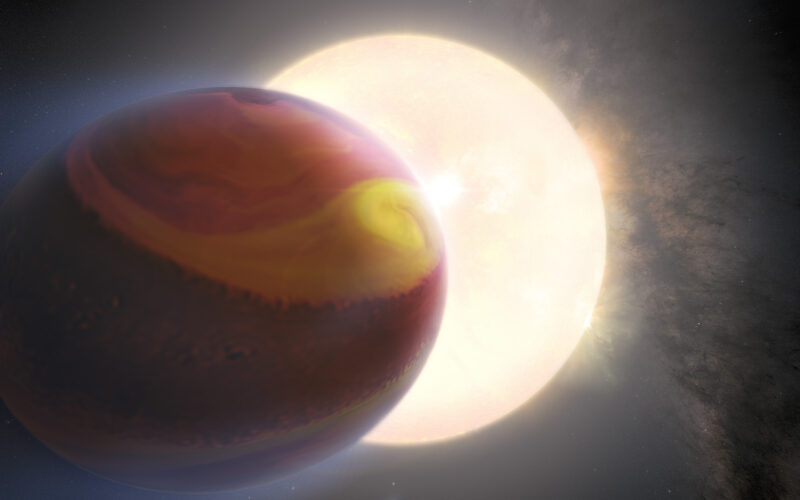This visualization shows the weather patterns on the distant planet Tylos, aka WASP-121 b. It lies some 880 light-years from Earth. Video via NASA/ ESA/ Quentin Changeat (ESA/STScI)/ Mahdi Zamani (ESA/Hubble).
NASA published this original article on January 4, 2024. Edits by EarthSky.
The 2024 lunar calendars are here! Best New Year’s gifts in the universe! Check ’em out here.
Weather on distant planet Tylos
By combining several years of observations from NASA’s Hubble Space Telescope along with computer modeling, astronomers have found evidence for massive cyclones and other dynamic weather swirling on a hot, Jupiter-sized planet 880 light-years away.
The planet, called Tylos or WASP-121 b, is not habitable. But this result is an important early step in studying weather patterns on distant worlds. And, perhaps, for eventually finding potentially habitable exoplanets with stable, long-term climates.

Observations of 3 years of weather
For the past few decades, detailed telescopic and spacecraft observations of neighboring planets in our solar system have shown turbulent, constantly changing atmospheres, just like on Earth. This variability should also apply to planets around other stars, too. But it takes lots of detailed observing and computational modeling to measure such changes.
To make the discovery, an international team of astronomers assembled and reprocessed Hubble observations of Tylos taken in 2016, 2018 and 2019.
They found that the planet has a dynamic atmosphere, changing over time. The team used sophisticated modeling techniques. These techniques demonstrated that weather patterns in the exoplanet’s atmosphere could explain the dramatic temporal variations.
The team found that Tylos’ atmosphere shows notable differences between observations. Most dramatically, there could be massive weather fronts, storms and massive cyclones. Scientists believe the large temperature difference between the star-facing side and the dark side of the exoplanet repeatedly creates and destroys weather patterns. They also detected an apparent offset between the exoplanet’s hottest region and the point on the planet closest to the star. Additionally, they found variability in the chemical composition of the exoplanet’s atmosphere (as measured via spectroscopy).
Models aided the observations
The team reached these conclusions by using computational models to help explain observed changes in the exoplanet’s atmosphere. Jack Skinner of Caltech, a co-leader of the study, explained:
The remarkable details of our exoplanet atmosphere simulations allow us to accurately model the weather on ultra-hot planets like WASP-121 b. Here we make a significant step forward by combining observational constraints with atmosphere simulations to understand the time-varying weather on these planets.
Team member Quentin Changeat, a European Space Agency research fellow at the Space Telescope Science Institute in Baltimore, Maryland, said:
This is a hugely exciting result as we move forward for observing weather patterns on exoplanets. Studying exoplanets’ weather is vital to understanding the complexity of exoplanet atmospheres on other worlds, especially in the search for exoplanets with habitable conditions.

An exoplanet extremely close to its star
Tylos is so close to its parent star that the orbital period is only 1.27 days. This close proximity means that the planet is tidally locked, so that the same hemisphere always faces the star. Another tidally locked example is our moon, which always has the same side pointed at Earth. On the star-facing side of Tylos, daytime temperatures approach 3,450 degrees Fahrenheit (1,900 C).
The team used four sets of Hubble archival observations of Tylos. One was a complete data-set that included observations of Tylos transiting in front of its star (taken in June 2016). The data also included Tylos passing behind its star (a secondary eclipse, taken in November 2016). Yet another data-set included the brightness of Tylos as a function of its phase angle to the star. That’s the varying amount of light received at Earth from an exoplanet as it orbits its parent star, similar to our moon’s phase-cycle. The scientists made these observations in March 2018 and February 2019.
Changeat said:
The assembled data-set represents a significant amount of observing time for a single planet. It’s currently the only consistent set of such repeated observations. The information that we extracted from those observations was used to infer the chemistry, temperature and clouds of the atmosphere of WASP-121 b at different times. This provided us with an exquisite picture of the planet changing over time.
Forecasting weather on an exoplanet
This visualization shows the temperature forecast spanning 130 exoplanet-days. The forecast is for sunrise, noon, sunset and midnight for the exoplanet Tylos, also known as WASP-121 b. Video via NASA/ ESA/ Quentin Changeat (ESA/STScI)/ Mahdi Zamani (ESA/Hubble).
Bottom line: With three years of data, astronomers using the Hubble Space Telescope said they have seen weather on an exoplanet: Tylos. It is an ultra-hot Jupiter with a dynamic, changing atmosphere.
Source: Is the atmosphere of the ultra-hot Jupiter WASP-121b variable?











